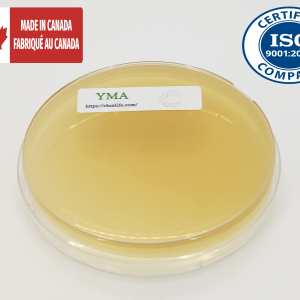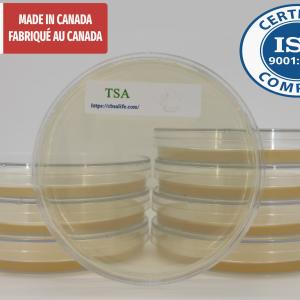Mueller Hinton Agar is recommended for antimicrobial disc diffusion susceptibility testing of common, rapidly growing bacteria by the Bauer-Kirby method, as standardized by the Clinical and Laboratory Standards Institute (CLSI).
INTENDED USE
Mueller Hinton Agar is recommended for antimicrobial disc diffusion susceptibility testing of common, rapidly growing bacteria by the Bauer-Kirby method, as standardized by the Clinical and Laboratory Standards Institute (CLSI).
NOTE: The recommended medium for disc diffusion susceptibility testing of Streptococcus pneumoniae is Mueller Hinton agar with 5% sheep blood. The recommended medium for Haemophilus influenzae is Haemophilus Test Medium (HTM) Agar. The recommended medium for Neisseria gonorrhoeae is GC Agar with 1% defined growth supplement. Interpretive criteria are provided in the CLSI Document M100 (M2), which is included with CLSI Document M2, Performance Standards for Antimicrobial Disk Susceptibility Tests; Approved Standard.
SUMMARY AND EXPLANATION
Mueller Hinton Agar was originally developed for the cultivation of pathogenic Neisseria. However, these organisms are now commonly isolated on selective media.
Because clinical microbiology laboratories in the early 1960s were using a wide variety of procedures for determining the susceptibility of bacteria to antibiotic and chemotherapeutic agents, Bauer, Kirby and others developed a standardized procedure in which Mueller Hinton Agar was selected as the test medium. A subsequent international collaborative study confirmed the value of Mueller Hinton Agar for this purpose because of the relatively good reproducibility of the medium, the simplicity of its formula, and the wealth of experimental data that had been accumulated using this medium.
The CLSI has written a performance standard for the Bauer-Kirby procedure and this document should be consulted for additional details. The procedure is recommended for testing rapidly growing aerobic or facultatively anaerobic bacterial pathogens, such as staphylococci, members of the Enterobacteriaceae, aerobic gram-negative rods; e.g., Pseudomonas spp. and Acinetobacter spp., enterococci and Vibrio cholerae. The procedure is modified for testing fastidious species; i.e., H. influenzae, N. gonorrhoeae and S. pneumoniae and other streptococci.
Mueller Hinton Agar is manufactured to contain low levels of thymine and thymidine and controlled levels of calcium and magnesium. Thymine and thymidine levels of raw materials are determined using the disc diffusion procedure with trimethoprim-sulfamethoxazole (SXT) discs and Enterococcus faecalis ATCC™ 33186 and/or 29212. Calcium and magnesium levels are controlled by testing raw materials and supplementing with sources of calcium and/or magnesium as required to produce correct zone diameters with aminoglycoside antibiotics and Pseudomonas aeruginosa ATCC 27853.
Mueller Hinton agar complies with requirements of the World Health Organization and is specified in the FDA Bacteriological Analytical Manual for food testing.
Unsupplemented Mueller Hinton agar, although adequate for susceptibility testing of rapidly growing aerobic pathogens, is not adequate for more fastidious organisms such as S. pneumoniae. The CLSI Document M2, Performance Standards for Antimicrobial Disk Susceptibility Tests, recommends Mueller Hinton agar supplemented with 5% defibrinated sheep blood.
PRINCIPLE
Acid hydrolysate (digest) of casein and beef extract supply amino acids and other nitrogenous substances, minerals, vitamins, carbon and other nutrients to support the growth of microorganisms. Starch acts as a protective colloid against toxic substances that may be present in the medium. Hydrolysis of the starch during autoclaving provides a small amount of dextrose, which is a source of energy. Agar is the solidifying agent.
The Bauer-Kirby procedure is based on the diffusion through an agar gel of antimicrobial substances which are impregnated on paper discs. In contrast to earlier methods which used discs of high and low antimicrobial concentrations and which used the presence or absence of inhibition zones for their interpretation, this method employs discs with a single concentration of antimicrobial agent and zone diameters are correlated with minimal inhibitory concentrations (MIC).
In the test procedure, a standardized suspension of the organism is swabbed over the entire surface of the medium. Paper discs impregnated with specified amounts of antibiotic or other antimicrobial agents are then placed on the surface of the medium, the plate is incubated and zones of inhibition around each disc are measured. The determination as to whether the organism is susceptible, intermediate or resistant to an agent is made by comparing zone sizes obtained to those in the CLSI Document M100(M2).
Various factors have been identified as influencing disc diffusion susceptibility tests. These include the medium, excess surface moisture on the medium, agar depth, disc potency, inoculum concentration, pH and β-lactamase production by test organisms.
| Weight | N/A |
|---|---|
| Dimensions | N/A |
| Container | 60mm Petri Dish, 100mm Petri Dish |
| Package | 1, 5, 10, 20 |
Only logged in customers who have purchased this product may leave a review.





Reviews
There are no reviews yet.